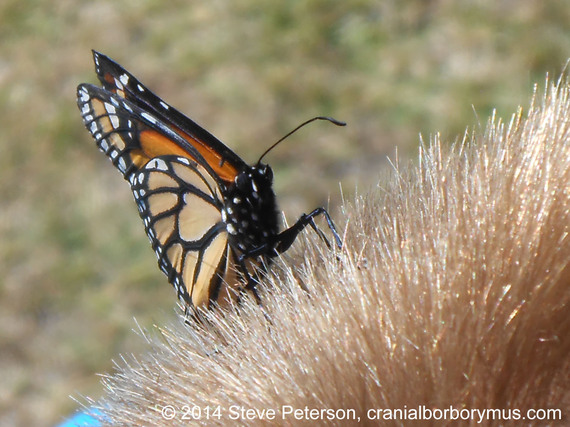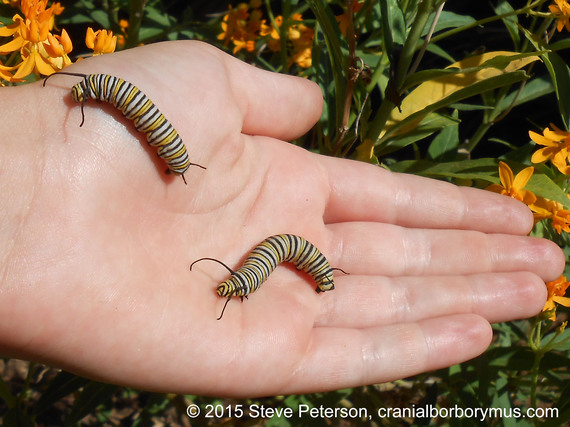
image: One of the first Monarch butterflies we "raised" lands on my son's head as if to say goodbye before it flutters off into the wild.
According to the U.S. Fish and Wildlife Service...
"While Monarchs are found across the United States -- as recently as 1996 numbering some 1 billion -- their numbers have declined by approximately 90 percent in recent years... North American monarch butterflies are in trouble. Threats, including loss of milkweed habitat needed to lay their eggs and for their caterpillars to eat, are having a devastating impact on their populations and the migration phenomenon. Unless we act now to help the Monarch, this amazing animal could disappear in our lifetime."
I first became aware of the critical situation facing the Monarch butterfly about two years ago. My wife, two kids, and I live in Santa Barbara, California, and for many years we have visited the nearby Elwood Butterfly Preserve (a coastal grove of eucalyptus trees) where every year western Monarch butterflies congregate to spend the winter. It is an awe-inspiring site to see! Thousands of butterflies huddle together in clumps on the eucalyptus tree branches. When the sun hits a clump, the butterflies take to the air in a cloud of frenzied fluttering. Two years ago we met a docent who informed us of the dramatic drop in the number of Monarchs and the challenges they face. The docent also had an actual living Monarch caterpillar with her that she let my wife and two kids and I hold. I hadn't seen or held a Monarch caterpillar since my childhood growing up in Reno, Nevada, when I would find them on wild milkweed plants. The combination of my childhood memories, hearing about the Monarch's current situation, and seeing the wonder on my two kid's faces as they held the little wiggly caterpillar, led me to decide that we needed to start growing milkweed.
Since then, I've learned that growing a "weed" can be much more difficult than one would think. But we have managed to get a few milkweed plants established, and have seen many a caterpillar and a few chrysalises and butterflies as well. Growing milkweed can be a challenge. I've learned that a single Monarch butterfly can lay literally hundreds of eggs, resulting in a "horde" of hungry little caterpillars that can eat all the milkweed thus exhausting their food supply before all of the caterpillars are full size, while decimating backyard milkweed plants in the process. I've also learned that the Monarch caterpillar has a lot of natural predators, including the dreaded Tachinid fly, which can kill of an entire generation of caterpillars before any have a chance to become butterflies.
The challenges I face trying to help the Monarch butterfly in my backyard mirror the challenges the Monarch faces across the United States. I've learned that it takes A LOT of milkweed to support Monarch butterflies because they can lay so many eggs. And Monarch butterflies need to be prolific egg-layers because in the wild, only a small fraction of the caterpillars will survive a phalanx of pests and diseases to turn into butterflies. Having a single small milkweed plant in one's backyard is a noble effort, but a single plant simply isn't enough. Similarly, having "some" remaining milkweed across the United States simply isn't enough. We need more milkweed, but unfortunately with modern agriculture, there is less. Something needs to be done. Fortunately, the US Fish and Wildlife Services just approved spending $20 million dollars over the next five years for supporting ongoing educational outreach programs and for conserving monarch breeding & migration habitat in various priority areas of the United State. While this is a noble effort to be roundly applauded and is also a great start, it should only be seen as a start. I've learned from growing milkweed and "raising" Monarch caterpillars that the Monarch population is not guaranteed. I'd rather not see a declining population (like we have for twenty years) and assume it will stabilize at some point and all will be well. It's fantastic that more and more people are growing milkweed in their backyards, but we need more than that. Hopefully we can come up with a way to support the comeback of this "weed" so the Monarch has an ample and reliable food source, and future generations of kids will get their chance to hold a wiggly Monarch caterpillar and watch in amazement as a caterpillar turns into a chrysalis, and then later emerges as a regal Monarch butterfly.
